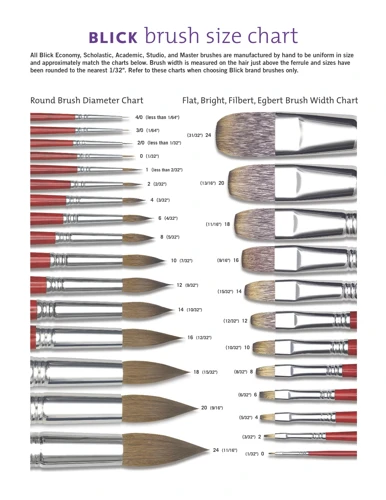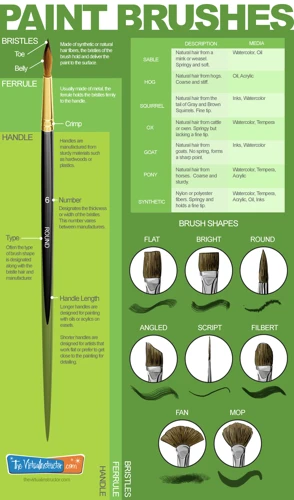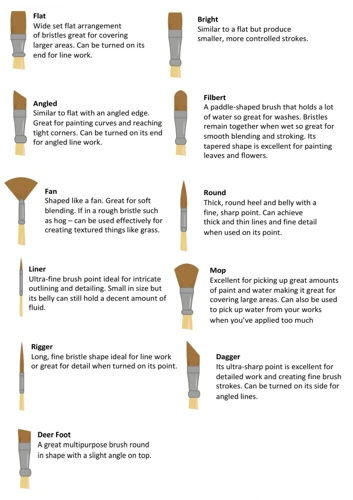Embarking on a painting journey can be as daunting as it is exciting. With the multitude of art supplies available, it’s essential to begin with a solid foundation. This ultimate guide to paint brushes for beginners is tailored to simplify your initiation into the world of art, ensuring you select the right tools to express your creativity.
Understanding Paint Brushes: An Introduction
Before delving into the various types of brushes, it’s crucial to grasp the basics. Paint brushes are the conduit between your artistic vision and the canvas. They come in a variety of sizes and shapes, each designed for specific techniques and effects. Comprehending these tools’ intricacies is the first step to harnessing their potential.
Art Brush Selection: Starting Your Artistic Journey
Art brush selection is a personal and significant process. It’s about finding a balance between quality, function, and comfort. A well-chosen brush becomes an extension of your hand, translating your artistic intent onto the canvas with precision and ease.
Deciphering Paint Brush Sizes and Shapes
The variety of paint brush sizes and shapes can be overwhelming for newcomers. Understanding the differences and uses of each will help you create the strokes and details you desire in your artwork.
Paint Brush Sizes: A Comprehensive Overview
Paint brush sizes are generally indicated by a number on the handle. They can range from 0000 (extremely fine) to 24 (very large) and even higher. The size you choose should correspond to the scale of your project and the level of detail required. Larger sizes cover more area, while smaller ones are perfect for delicate work.
Paint Brush Shapes: Choosing the Right Tool for the Job
- Round: Tapered to a fine point, ideal for detailed work.
- Flat: Offers crisp edges, suitable for filling large areas or creating bold strokes.
- Filbert: Oval-shaped, blending the features of round and flat brushes.
- Fan: Spread bristles, used for texturing, smoothing, and blending.
- Angular: Slanted bristles, excellent for curved strokes and filling corners.
A Beginner’s Primer on Paint Brush Types
Distinguishing between paint brush types is fundamental in creating diverse textures and styles in your paintings. Each type serves a unique purpose and can significantly impact your artwork’s outcome.
Exploring the World of Flat and Round Brushes
Flat brushes are the workhorses of the brush world, versatile for both broad strokes and sharp lines. Round brushes, with their pointed tips, are indispensable for adding fine details and achieving a variety of line thicknesses.
Specialty Brushes: Enhancing Your Painting Technique
Beyond the basics, specialty brushes can add a new dimension to your work. Rigger brushes, with long, thin bristles, are perfect for continuous lines, like tree branches or hair. Palette knives, while not brushes, are also a valuable tool for mixing paint and creating dynamic textures on the canvas.
Natural vs. Synthetic: Making an Informed Choice
Brush bristles come in natural or synthetic materials. Natural bristles, often made from animal hair, are prized for their softness and ability to hold paint. Synthetic bristles, made from nylon or polyester, offer durability and are often more affordable. Your choice will depend on the medium you use and your personal preferences.
Choosing Paint Brushes for Different Mediums
Different painting mediums require specific types of brushes for the best results. The density, texture, and drying time of your chosen medium will dictate the best brushes for painting with it.
Best Brushes for Painting with Acrylics
Acrylics are versatile and can be used with both natural and synthetic brushes. However, synthetic brushes are often preferred for their ability to withstand the quick-drying nature of acrylic paints.
The Ideal Brushes for Watercolor and Oil Painting
Watercolors work best with soft, absorbent brushes, which tend to be natural-hair brushes. In contrast, oil paints are best applied with stiff brushes, which can be either natural hog-bristle or high-quality synthetics designed for this purpose.
Beginner Painting Tips: Brush Techniques and Care
Mastering brush techniques and proper care will ensure the longevity of your brushes and the continual improvement of your skills.
Mastering Basic Painting Techniques with Various Brush Types
Experimenting with different strokes and pressures can lead to exciting results. Try using the side of a flat brush for thin lines or the full width for bold, sweeping strokes. With round brushes, vary the pressure to go from fine lines to broader strokes.
Maintaining Your Brushes: Cleaning and Storage Tips
Cleaning your brushes thoroughly after each use will extend their life and maintain their shape. Use a gentle soap and warm water for cleaning, reshape the bristles, and allow them to dry horizontally. Proper storage is equally important; hang them vertically with bristles downward or lay them flat in a protective case.
Investing in Quality: Selecting the Best Brushes for Painting
Investing in quality brushes will enhance your painting experience. Higher-quality brushes tend to maintain their shape and deliver a smoother application of paint, making them a worthwhile investment for any budding artist.
Top Paint Brush Brands for Beginners
Brands like Winsor & Newton, da Vinci, and Princeton have established reputations for creating quality brushes that are suitable for beginners and professionals alike. Their offerings provide a good balance of price and performance for those starting out.
Paintbrush Sets: Building a Versatile Collection
Starting with a set is a cost-effective way to acquire a range of brush types and sizes. Look for sets that include a variety of shapes, such as round, flat, and filbert, to allow for experimentation with different techniques.
Furthering Your Art: Additional Resources and Reading
As your skills grow, so should your knowledge. There are numerous resources available to help you refine your techniques and learn more about the art of painting.
Advanced Techniques and Tips for the Aspiring Artist
Books, online tutorials, and videos can provide in-depth knowledge on advanced painting techniques. They can offer guidance on topics such as color theory, composition, and brushwork that are crucial for developing artists.
If you’re diving into the world of painting, getting the right tools is essential for achieving the desired results. For those just starting out, understanding the various sizes and shapes of paint brushes can be quite overwhelming. That’s why we’ve put together a comprehensive Beginners Guide to Paint Brush Sizes and Shapes to help you make an informed decision.
But there’s more to painting than just brushes. The sheen of the paint you choose can dramatically affect the look and feel of your project. Make sure to read our Beginner’s Guide to Sheen Levels in Paint to learn about the differences between matte, satin, gloss, and more.
If you’re interested in giving your furniture a unique, vintage look, our Beginner’s Guide to Distressing Furniture with Chalk Paint might be just what you need. It’s a fantastic way to add character and age to your pieces.
And for those considering a more advanced approach, why not look into using a paint sprayer? Our Guide to Choosing a Paint Sprayer will walk you through the different types and help you pick the best one for your projects.
Whether you’re painting a room, furniture, or a canvas, these guides will set you up for success.
Continuing Your Education: Workshops and Online Classes
Workshops and online classes are invaluable for personalized instruction and feedback. They can help you to see improvements in your work quickly and give you the confidence to tackle more complex projects.
In conclusion, the world of painting is vast and full of potential. With this paintbrush guide for beginners, you’re well-equipped to start choosing paint brushes and exploring the art of painting. Remember, the best way to learn is through practice and experimentation. So, gather your brushes and let your creativity flow onto the canvas.


